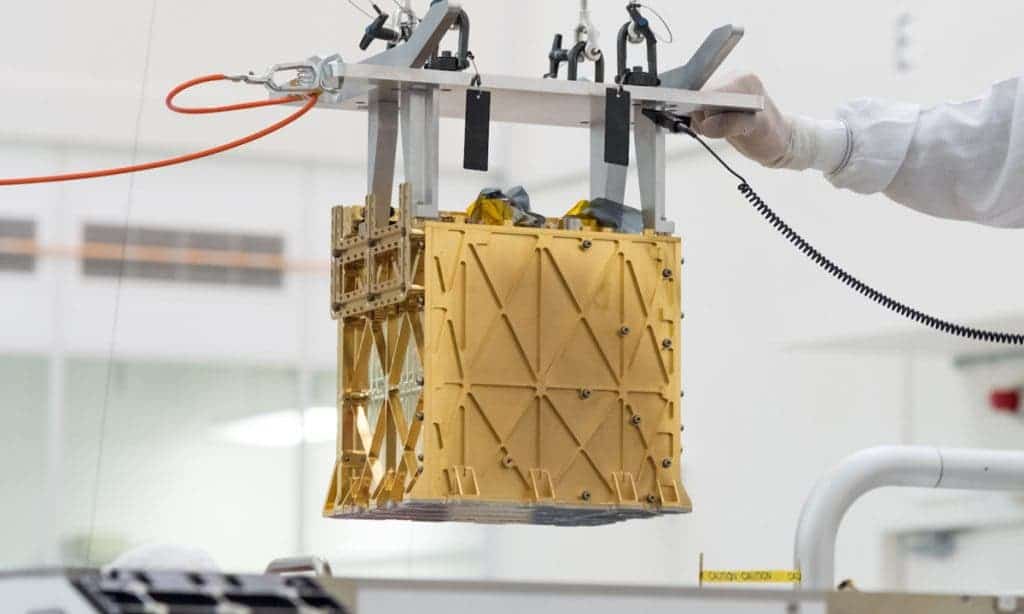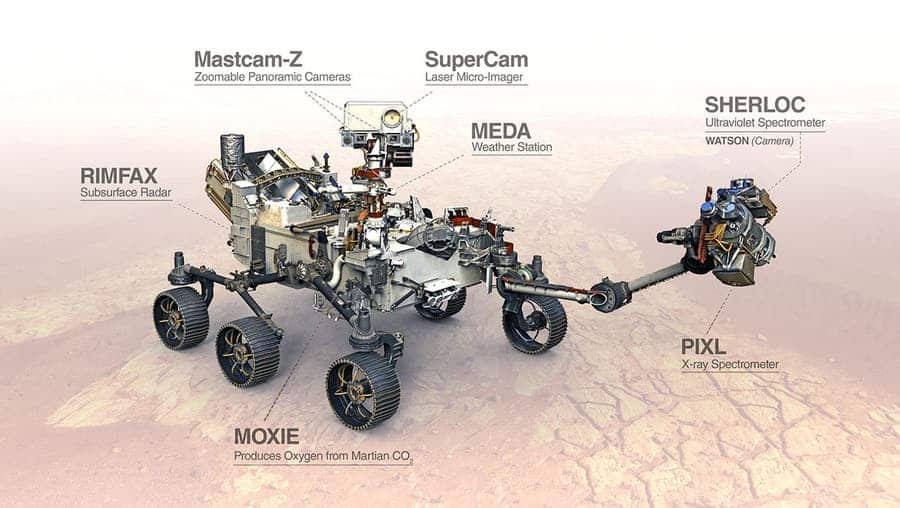The toaster-sized experimental MOXIE instrument aboard the rover extracted oxygen from Martian carbon dioxide. It’s only a proof of concept, but it’s an important one, as it suggests that one day Martian astronauts could make their own oxygen for breathing and rocket fuel.

A tree on Mars
The atmosphere of Mars is very different from that of Earth. It’s much thinner (about 96% thinner) and also has a different chemical make-up: it’s poor in oxygen and rich in carbon dioxide. Future astronauts won’t have much use for carbon dioxide, but pure oxygen is a different matter.
“When we send humans to Mars, we will want them to return safely, and to do that they need a rocket to lift off the planet. Liquid oxygen propellant is something we could make there and not have to bring with us. One idea would be to bring an empty oxygen tank and fill it up on Mars,” says Michael Hecht, Principal Investigator of the Perseverance project.
Researchers have been working on ways to do this for a while, and with the Perseverance rover, they got a chance to actually try it out — not in a lab on Earth, but right on Mars.
The MOXIE instrument aims to help humans explore Mars by making OXygen. It works “In situ” (in place) on the Red Planet, and is an Experiment.” As always, NASA loves to toy with acronyms, but the instrument did its job excellently so far.
MOXIE’s first run produced 5.4 grams of oxygen in an hour. The power supply used for the experiment limits potential production to 12 g/hr — about the same amount that a large tree would produce. It’s not spectacular, but it’s the first time this has ever been done, and it could also be scaled up .
“This is a critical first step at converting carbon dioxide to oxygen on Mars,” said Jim Reuter, associate administrator STMD. “MOXIE has more work to do, but the results from this technology demonstration are full of promise as we move toward our goal of one day seeing humans on Mars. Oxygen isn’t just the stuff we breathe. Rocket propellant depends on oxygen, and future explorers will depend on producing propellant on Mars to make the trip home.”
The conversion process requires high levels of heat: 1,470 degrees Fahrenheit (800 Celsius). To withstand these temperatures and carry out the process safely, MOXIE is built from heat-tolerant materials, including 3D-printed nickel alloys and a light aerogel that acts as a buffer, holding the heated air inside. MOXIE is coated with a thin gold layer that reflects infrared heat and ensures that it won’t damage other parts of Perseverance.

Live off the land
This bodes well for future Mars missions, as transporting oxygen all the way there would be quite a hassle. Oxygen tends to take a lot of space, and it’s very unlikely that astronauts to Mars will be able to carry their own oxygen. Extracting oxygen from the Martian soil or atmosphere will therefore be crucial for future missions.
To get a team of four astronauts off of Mars, a future mission would require about 15,000 pounds (7 metric tons) of rocket fuel and 55,000 pounds (25 metric tons) of oxygen. Astronauts that would carry experiments and potentially spend a lot of time on the Red Planet would also require oxygen (though far less than this). With instruments like MOXIE, they could live off the land — quite literally.
“MOXIE isn’t just the first instrument to produce oxygen on another world,” said Trudy Kortes, director of technology demonstrations within STMD. It’s the first technology of its kind that will help future missions “live off the land,” using elements of another world’s environment, also known as in-situ resource utilization.
“It’s taking regolith, the substance you find on the ground, and putting it through a processing plant, making it into a large structure, or taking carbon dioxide – the bulk of the atmosphere – and converting it into oxygen,” she said. “This process allows us to convert these abundant materials into useable things: propellant, breathable air, or, combined with hydrogen, water.”
Now that the technology demonstration was successful, NASA will attempt to extract oxygen at least nine more times over the next two years (Earthly years, that is). The goal is to test the equipment in different conditions to see if it keeps working properly.
Meanwhile, Perseverance will continue its mission to search for signs of microbial life on Mars, analyzing its geology and past climate, as well as paving the way for human exploration.

Was this helpful?



